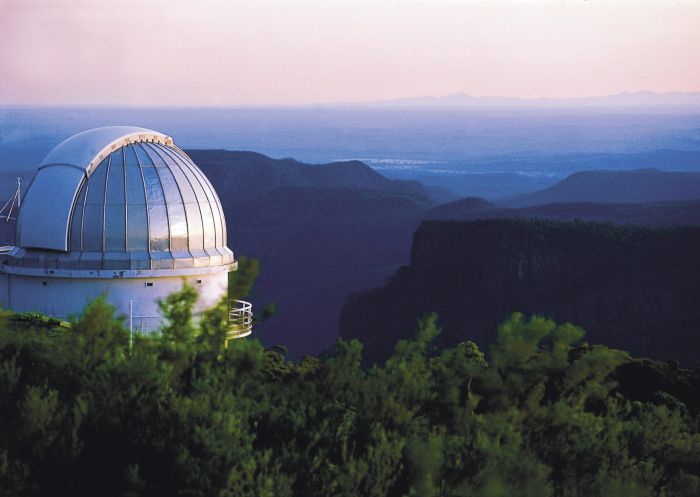

Coonabarabran
Neilson Park on the banks of the Castlereagh River, Coonabarabran



The gateway to Australia’s first Dark Sky Park, Coonabarabran ('Coona' to locals) is the ultimate destination for gazing at the heavens – clean air, high altitudes, low humidity and a lack of light pollution all unite to create an unparalleled stargazing experience. The town itself comes with plenty of country swagger; get set to meet a few local characters in main-street pubs.
In NSW’s Warrumbungle region, Coonabarabran is known as the ‘capital of Australian astronomy’ – and there's good reason why. The region has zero light pollution and it's home to the nation's first Dark Sky Park – an honour bestowed on Warrumbungle National Park by the International Dark-Sky Association in 2016. Needless to say, there are a number of observatories across the region, and some are open to the public year-round – amazing night sky experiences through large telescopes await.
Warrumbungle National Park is a hauntingly beautiful reserve home to the Warrumbungle Range, a dramatic chain of mountains that cuts through this part of the state. Follow the trail of colonial explorer and botanist Allan Cunningham and stop at the Cunningham’s campsite before discovering Pandoras Pass, a natural break he found through the chain of peaks.

Camping, Warrumbungle National Park
Inside the park is the Siding Spring Observatory, home to Australia’s largest optical telescopes. This astronomical research facility is open to the public during the day – visit and you’ll learn about the solar system and the universe at the interactive Exploratory Centre. If you’re in the region over the Labour Day long weekend in October, you can also partake in the Star Fest celebration, which is your chance to explore the whole site, talk with astronomers and peer through telescopes at the heavens.
Nearby is the Milroy Observatory, where you can join an astronomer on an amazing and entertaining journey through the Southern Night Sky. The show starts with a tour of the evening sky and then a number of bright and deep-sky objects are observed with the outdoor telescope. See planets, galaxies, nebulas and star clusters, among other amazing dark-sky wonders.

Siding Spring Observatory, Coonabarabran
For earthly observations, explore the rare crystals and fossils at the Crystal Kingdom. This exhibit contains some of the world's most coveted (and most colourful) zeolite crystals, not to mention rare fossils that are found nowhere else in the world.
Meanwhile, the fossilised skeleton of the largest marsupial to have ever lived is at the Australian Museum Diprotodon Exhibition, within the Coonabarabran Visitor Information Centre. Visit and you’ll learn that the diprotodon is often likened to a giant wombat, with these remains found just down the road at Cox’s Creek.

Australian Museum Diprotodon Exhibition, Coonabarabran - Credit: Australian Museum Diprotodon Exhibition
When you’re not in Warrumbungle National Park, lace up your hiking shoes to explore the Pilliga Forest, a breathtaking landscape made up of Pilliga Nature Reserve, Timmallallie National Park, Pilliga West and East State Conservation Areas. This vast forest spans more than 500 million hectares and features 2,000km of public access trails, so there's a lot to explore either by walking or car touring. You can set up camp at the Sculptures in the Scrub campground in Timmallallie National Park. Be sure to take short walk at Sandstone Caves to find out about this important Aboriginal site and the Gamilaraay People's connections to this ancient landscape.

Pilliga Forest Lookout Tower, Pilliga - Credit: Andrew Pearson
You’ll find plenty of accommodation options in Coonabarabran, from motels and pubs to cottages, farmstays, caravan parks and campgrounds. You can even stay at the Skywatch Observatory, which has a single suite and offers guided tours of the night sky when you check in.

Barkala Farmstay - Home of Pilliga Pottery, Coonabarabran - Credit Anna Tenne
Coonabarabran is about two hours’ drive northeast of Dubbo. The drive from Sydney to Coonabarabran, via the Blue Mountains or the Hunter Valley wine region, is six hours. For earthly observations, explore the rare crystals and fossils at the Crystal Kingdom. The fossilised skeleton of the largest marsupial to have ever lived is at the Australian Museum Diprotodon Exhibition. There are also scenic drives and day trips to the Pilliga Forest, a breathtaking landscape.
Stay connected to Visit NSW for all the latest news, stories, upcoming events and travel inspiration.
All the insider news, tips and inspiration you need to plan your next trip, delivered straight to your inbox.
Sign UpVisitNSW.com is the official tourism site for Destination NSW.
© Copyright 2025 Destination NSW. All rights reserved